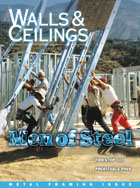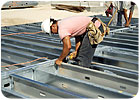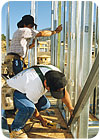

Photo courtesy of the Steel Framing Alliance
The Basics
Wood comes from trees and while trees are renewable, do we really want to keep slaughtering our forests? I am not a tree-hugging environmentalist, but I live in the Pacific Northwest, where trees and the lumber industry is king. I have been on weekend get-aways on the Olympic Peninsula, where seeing a clear-cut forest leaves a sick feeling in your stomach. The wood industry belays our fears of clear-cutting forests with the new faster growing tress. Wow, the answer to our prayers! Think again. There are always consequences for every action, and building with fast-growing trees has consequences. The new faster-growing timber has wider growth rings in the tree trunk. We all know how a tree ring represents one year of growth in a tree’s life. Faster growing trees results in wider growth rings and these rings are filled with more saturated cellular fibers. This in turn leads to a softer and more decay prone lumber. You do not have to take my word for it, ask any framer who has been around for more than 30 years and he will testify that today’s lumber does not compare to the lumber of the 1970s. It is softer wood.The other negative aspect of fast growth lumber is that it will shrink more. The wood studs do not shrink in length, but they do get thinner. The dimensional lumber used on the plate line in multi-floor wood framed multi-family construction will compress more today than in the past. Ask any stucco contractor who has been around. Experience has taught them a single-piece control joint at the floor line that worked in the past, will now crush completely flat. Today, you need to consider a two-piece expansion joint that will allow for greater movement. Nothing has changed, except that the new fast-growth lumber compresses much more than it did in the past.
Have you been to a big box store and bought any 2 x 4s lately? You have to go through several pieces to find a few that are reasonably straight. There is usually a pile of twisted 2 x 4s off to the side. I have always wondered what they do with all of those spaghetti 2 x 4s? Then you get them home and 10 to 20 percent of them start to twist before you get a chance to use them. Steel studs do not decay, rot, twist or compress from a loss of moisture, and they are recyclable.
The Simple
A few years back, steel stud work was pretty much limited to non-load-bearing commercial work. If you wanted to use steel studs on any load-bearing work, commercial or residential, you had to hire an engineer. That engineer had to be familiar with load-bearing structural steel. Pardon the pun, but qualified engineers weren’t exactly growing on trees. If you were lucky to find an engineer who knew that bridging had nothing to do with the Golden Gate or Brooklyn Bridges, he would be either cost-prohibitive or booked for months. Today there are several engineers familiar with cold-formed steel framing and these guys are good. Most steel framing manufacturers have engineers on staff that are readily available and are only too happy to assist clients with designs, bidding and project management. Today’s engineers are not limited to strict basic formulas and are more creative than their predecessors.The steel stud manufacturers and the engineers are making it much more convenient to build single-family, multi-family and commercial projects out of steel framing. Today these guys are helping us make it simple.

Photo courtesy of the Steel Framing Alliance
The Amazing
The one piece of the puzzle that was missing was innovative, easy-to-use products for the guys in the field. In years past, you had studs, track and a weak screw gun. Let’s start with the screw gun. The young guys today can not appreciate how today’s tools are light years ahead of what we had in the 1970s. I remember the huge bulky screw guns with weak short-life batteries. I still have one of those old tools. When I bought it, I thought it was awesome. Today’s tools are far superior. Did I mention that old weak clunker cost more than today’s awesome tools, and that was in 1980 dollars!Today, the tools and products are amazing for the steel framing industry. Nail guns that shoot into metal studs. The deflection tracks and clips all invented to make assembling steel framing faster and safer. I can remember opening a Simpson catalog on steel hangers designed for wood framing and thinking “is there anything they don’t have for wood framing?” The steel framing accessories were pretty skimpy for many years. Well, today the steel framing industry has the same catalogs and has finally caught up with the wood people. I would dare to say, they are even surpassing them for creativity. There are so many designs for head-of-wall deflection, corner studs that allow full access for plumbing runs, pre-insulated headers, slide clips for curtain walls, bridging bars that snap in place, clips that attach to top track and seal to the ceiling and a multitude of curved type tracks. Truly amazing.
The Future of Standards
The future is definitely in cold-formed steel framing. Take note: I did not say “light-gauge steel framing.” If you sit on an ASTM or any steel framing committee you get in trouble for using the term “light-gauge steel framing.” The term light-gauge has changed to cold-formed steel framing. This is because the industry has moved away from using gauge thickness to mil thickness. By definition, gauge thickness had some wide allowable tolerances and this made engineers never really know how strong one manufacturer’s 16-gauge stud was as compared to another manufacturer’s. Mil thickness is an absolute measurement. From now on it is mil thickness that counts. I suppose the guys in the field will forever be using the terms 20-gauge studs, 16-gauge joists and 25-gauge hat channel. However, every tradesman should know the newer standards will reflect the modern mil thickness as opposed to the old gauge standards. Another reason was the globalization factor. The rest of the world uses mil thickness, since the world is getting smaller and we are moving toward the global terminology.Gauge thickness is an obsolete method of specifying sheet and strip steel thickness. Gauge numbers are rough estimates to the true thickness of steel. Mil thickness provides accuracy. Here is a simple chart to compare the new mil thickness to the old reference gauge number.
18 mils 25 Gauge
27 mils 22 Gauge
30 mils 20-Drywall
33 mils 20-Structural
43 mils 18
54 mils 16
68 mils 14
97 mils 12
ASTM
The American Society of Testing Materials (ASTM) is the grandfather of standards. If you are a contractor and just getting into steel framing or even a seasoned pro, there are some basic tips or guidelines/standards you should know about when dealing with ASTM. As a contractor (installer), do not concern yourself with the manufacturing standards like ASTM C 645, “The Specification for Non-Load-bearing Steel Studs and Related Accessories,” unless you plan to make your own studs; that’s for the manufacturers and dealers. Ask the supplier to provide documentation that the materials you are buying meet the appropriate ASTM standards that are referenced in the specifications.The two ASTM’s you do need to be aware of are ASTM C-754, “The Standard Specification for Installation of Steel Framing Members to Receive Screw-Attached Gypsum Panel” and ASTM C1007, “The Standard Specification for Installation of Load-bearing (Transverse and Axial)Steel Studs and Related Accessories.”
AISI
The American Iron and Steel Institute is a good resource for steel framing standards. A must for any contractor engaging in load-bearing steel framing is the AISI “Standard for Cold-Formed Steel Framing-General Provision.” This standard contains definitions, corrosion protection requirements, product description, installation guidelines, alignment requirements, sheathing spans, connections and other useful information. Another good source for this document and other generic information and details on steel framing is the Steel Framing Alliance.www.steelframingalliance.comFor those who are not familiar with steel framing there are some basics you need to know to get started.
Deflection Criteria
A significant difference in the switch from wood to steel studs is the deflection criteria. Because steel has so much design flexibility with width and thickness of the studs, contractors need to be aware of the minimum deflection criteria for walls. Unlike wood studs, all metal studs are not created equal. Contractors should also be aware of the recommended deflection criteria for walls with specific finishes. For interior walls the code refers to the deflection of walls with flexible or brittle finishes. Flexible finishes would be considered products like gypsum wallboard. Brittle finishes would be considered plaster.The wall and ceiling industry “recommends” L/240 for walls with flexible finishes and L/360 for walls with a brittle finish. These recommendations are more rigid than code minimums and are meant to minimize problems like cracking, joint ridging and other related problems with wall deformation. Do not be afraid to recommend a higher standard than the code minimums. Explain the benefits of higher standards and the caveats with using only the minimums. I think you will find more building owners and designers willing to spend a few dollars more for a superior system with less problems.
Get a copy of each standard and look them over. This is a good idea for the veterans too. There are a lot of gray areas with installing steel framing that the codes and standards are silent on. Walls and Ceilings will cover areas considered an industry standard in future issues.
Steel is definitely the future. If you are not using it, you will. If you think you can avoid it, you can’t. It’s kind of like computers: They are here and unless you are about to retire soon, you better start educating yourself. A good place to start is with your local steel sales representatives; they can help get you started on the right track.

